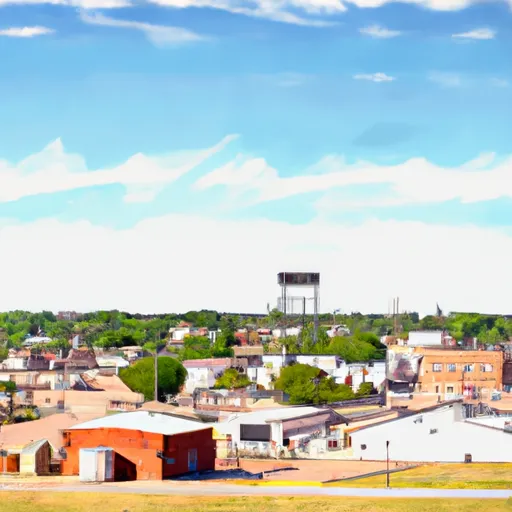-
 Snoflo Premium
Snoflo Premium
Get unlimited access to all our content
With no Ad interruptions! - Start Your Free Trial Login with existing account
Walters
Eden Index
Climate
9.7
•
Recreation
•
Community
1.8
•
Safeguard
4.3/10

Walters, Oklahoma is a small town located in Cotton County with a population of approximately 2,500 residents. The climate in Walters is classified as humid subtropical, characterized by hot summers and mild winters. Summers are typically hot and humid, with temperatures often reaching the high 90s°F (around 35°C), while winters are generally mild with temperatures averaging in the 40s°F (around 5°C).
Hydrologically, Walters benefits from being close to several water sources. The town is located near the western shore of Lake Lawtonka, which provides recreational opportunities such as fishing, boating, and swimming. Additionally, the nearby Medicine Creek and East Cache Creek also offer chances for outdoor activities like hiking, camping, and wildlife watching. These water bodies contribute to the hydrological makeup of the region and provide a source of natural beauty and recreational enjoyment for residents and visitors alike.
Overall, Walters, Oklahoma offers a pleasant climate for those who enjoy warmer temperatures, and the presence of various water sources presents opportunities for outdoor recreation and relaxation amidst natural surroundings.
What is the Eden Index?
The Snoflo Eden Index serves as a comprehensive rating system for regions, evaluating their desirability through a holistic assessment of climate health, outdoor recreation opportunities, and natural disaster risk, acknowledging the profound impact of these factors on livability and well-being.
Climate Health Indicator (CHI): 9.7
Walters receives approximately
826mm of rain per year,
with humidity levels near 79%
and air temperatures averaging around
17°C.
Walters has a plant hardyness factor of
7, meaning
plants and agriculture in this region tend to thrive during the non-winter months.
By considering the ideal temperature range, reliable water supplies, clean air, and stable seasonal rain or snowpacks, the Climate Health Indicator (CHI) underscores the significance of a healthy climate as the foundation for quality living.
A healthy climate is paramount for ensuring a high quality of life and livability in a region, fostering both physical well-being and environmental harmony. This can be characterized by ideal temperatures, reliable access to water supplies, clean air, and consistent seasonal rain or snowpacks.
Weather Forecast
Streamflow Conditions
Red-Lake Texoma
Area Rivers
Red-Lake Texoma
Snowpack Depths
Red-Lake Texoma
Reservoir Storage Capacity
Red-Lake Texoma
Groundwater Levels
Recreational Opportunity Index (ROI):
The Recreational Opportunity Index (ROI) recognizes the value of outdoor recreational options, such as parks, hiking trails, camping sites, and fishing spots, while acknowledging that climate plays a pivotal role in ensuring the comfort and consistency of these experiences.
Access to outdoor recreational opportunities, encompassing activities such as parks, hiking, camping, and fishing, is crucial for overall well-being, and the climate plays a pivotal role in enabling and enhancing these experiences, ensuring that individuals can engage in nature-based activities comfortably and consistently.
Camping Areas
| Campground | Campsites | Reservations | Toilets | Showers | Elevation |
|---|---|---|---|---|---|
| Lake Elmer Thomas Military - Fort Sill | None | 1,394 ft | |||
| Richardson State Park | None | 1,091 ft | |||
| Edgewater Park - Lawton | None | 1,246 ft | |||
| Collier Landing City | None | 1,241 ft | |||
| Hapgood RV Park | 12 | 881 ft | |||
| Robinsons Landing - Lake Lawtonka | None | 1,355 ft | |||
| Possum Kingdom State Park | 16 | 1,070 ft | |||
| Lake Arrowhead State Park | 71 | 952 ft | |||
| Medicine Creek RV Military - Fort Sill | None | 1,138 ft | |||
| East Side - Lake Lawtonka | 35 | 1,365 ft |
Nearby Fishing
Nearby Ski Areas
Catastrophe Safeguard Index (CSI):
The Catastrophe Safeguard Index (CSI) recognizes that natural disaster risk, encompassing floods, fires, hurricanes, and tornadoes, can drastically affect safety and the overall appeal of an area.
The level of natural disaster risk in a region significantly affects safety and the overall livability, with climate change amplifying these risks by potentially increasing the frequency and intensity of events like floods, fires, hurricanes, and tornadoes, thereby posing substantial challenges to community resilience and well-being.
Community Resilience Indicator (CRI): 1.8
The Community Resilience Indicator (CRI) recognizes that education, healthcare, and socioeconomics are crucial to the well-being of a region. The CRI acknowledges the profound impact of these elements on residents' overall quality of life. By evaluating educational resources, healthcare accessibility, and economic inclusivity, the index captures the essential aspects that contribute to a thriving community, fostering resident satisfaction, equity, and social cohesion.

